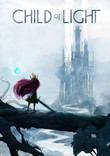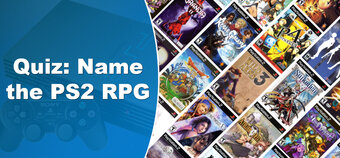That night Aurora went to sleep.
The fire burned down low.
She caught a chill that spread.
Her skin was cold as snow.
At dawn they found her vacant,
Aurora's light gone out.
Her father wept and pleaded
but there could be no doubt.
For all intents and purposes,
Aurora was dead.
And yet... once upon a time,
she awoke in a strange land instead.
All the best things in life have a rhyming prophecy - the LEGO Movie, The Hobbit, and now role-playing/platformer hybrid Child Of Light; the coming-of-age epic of a young girl named Aurora who, after 'dying' in reality, awakens in the surreal, dreamlike land of Lemuria. Tasked with recovering the sun, moon and stars which were stolen by the wicked Queen of Night (who happens to be Aurora's stepmother) in order to escape from a strange world and reunite with her father, along the way, she befriends the charming blue firefly Igniculus who aids her in her quest, as well as a colourful cast of quirky allies who fight alongside Aurora, like a jester who can't rhyme and a cowardly wizard seeking to prove himself.
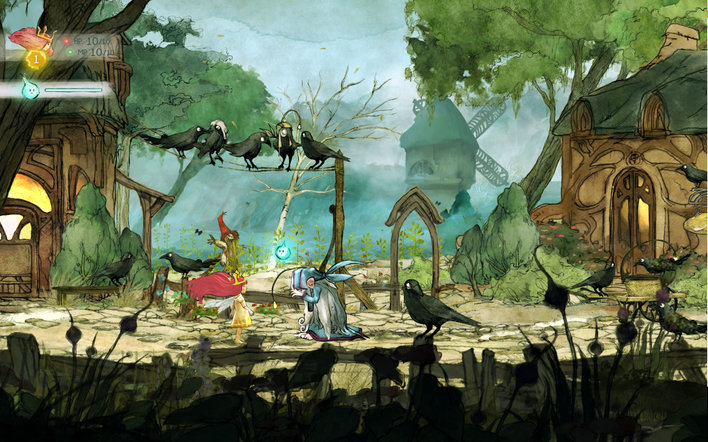
HEY! HEY LISTEN! HEY! HELLO!? HEY! Thankfully, Igniculus isn't as annoying as Zelda's Navi
The entire game is written in rhyming verse, essentially serving as an interactive poem with an in-depth role-playing game hidden amongst the elegant storytelling. Softly-spoken voiced narration surfaces at pivotal points in the plot but the game is otherwise unvoiced, with all character speech being text-based in a similar way to most role-playing games. In most games this would be a negative point, but in Child of Light, it somehow feels right, with the player reading aloud the intricate verse as they click through the dialogue.
The basic controls introduced in the opening tutorial are straight-forward and easy to pick up. In the normal game world, Aurora can do the typical run-and-jump platforming found in most games, but she quickly develops the ability to fly, opening up new exploration opportunities. There are also several puzzle sections involving crates, pressure switches and levers which need to be shoved around, very similar to those found in LIMBO (but thankfully much less frustrating), as well as points where you have to direct Igniculus' glow to illuminate or cast shadows over corresponding shapes in the scenery to unlock new areas and events. Of more challenge, though, are the turn based battles.
Reminiscent of old-school role-playing game series Final Fantasy and Grandia, Child of Light transports players to a separate battleground upon coming into contact with an enemy where a turn-based battle begins. Towards the bottom of the screen is a timeline, divided into the blue 'cooldown' section and a red 'charging attack' section, along which icons of both the player's party members and the enemies will move. During the 'cooldown' stage, players and enemies will essentially stand taunting each other, but once their icon reaches the transitional line between the 'cooldown' and 'charging attack stages', they can act. Presented with the typical options found in battles like these, you can choose to attack (with a regular physical attack, or a magical attack which costs a specified amount of MP), defend, cast buff/debuff spells on allies/enemies respectively (for example, slow down enemies and speed up allies), consume potions which restore health (HP) or magic points (MP), switch out with another party member (you can have 2 on the battlefield at once), or flee from the fight altogether. But only chickens do that.
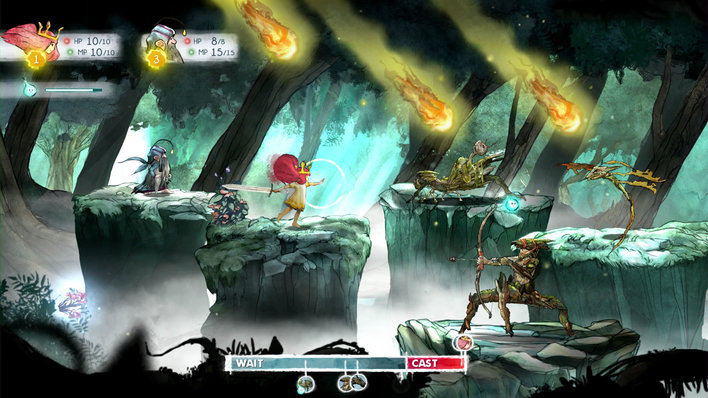
Make it rain.
The strategy here comes from understanding the interruption system; if the player attacks an enemy while the enemy's preparing an attack, your foe will be 'interrupted' and made to restart from the beginning of the 'cooldown' stage, essentially blocking their move. However, this also works in reverse, so choosing when to attack is every bit as important as what you actually do. If your foe's set to land an attack on you before you can clonk them, you're better off defending rather than risking an attack, reducing any damage that gets done to you, while netting you a large speed boost through the next 'cooldown' section to boot.
The best battle strategy tends to be to keep enemies 'interrupted' for as long as possible while attacking their weaknesses - typically, melee units are weak against magic as magic units are weak against melee, and certain enemies will be either vulnerable or invulnerable to certain elemental attacks (e.g. 'fire snakes' are strong against fire but vulnerable to water). Igniculus also comes in handy during battles and can either use his glow to blind enemies, slowing them down, or to heal allies. His limited 'glow' capacity can be restored by collecting 'wishes' from plants in both the battleground and in the wider environment of Lemuria, with the plants also dishing our orbs of green and purple light, which restore HP and MP respectively.
Defeating enemies and completing certain objectives alike will earn the player XP (experience points), which, when you've gained enough, will let you level up, gaining you still points and sometimes some shiny new items too. Skill points can be spent in the skill tree, offering a variety of unlockable stat boosts (e.g. defence + 5) and abilities/moves to use in combat. You can also combine the gem shards you'll collect on your journey, either as items random enemies drop or in one of numerous chests scattered throughout Lemuria, to craft 'oculi', strange gems that when applied to Aurora's equipment grant her stat bonuses and other enhancements. Oculi are centred around colour combinations; for example, a red and blue gem combined will result in a purple oculi, with each colour/type having different attributes, and your new, stronger oculi can be further combined to create even more colours/types of oculi, with the boosted effects stacking.
But perhaps the most iconic and stunning facet of Child of Light is its presentation - put briefly, the game is utterly gorgeous. Created using the same UbiArt framework (basically, programming stuff) as Rayman Origins and Rayman Legends, both excellent platformers with equally excellent, hand drawn, pastel graphics, the 2D world becomes a vibrant, living and breathing world with beautiful characters and enchanting surrounds. The earthy, watercolour layered environments are almost diorama-like, with the background expanding deeper into the screen from the foreground in several distinct layers, creating an unprecedented amount of depth for a 2D game. Parallax has never looked this good.
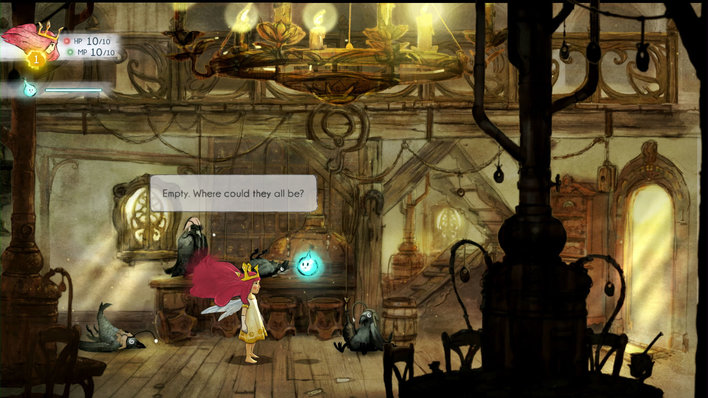
It's a seriously pretty game, packed full of charm.
Every new face is unique and quirky, iconic for their own little abnormality, with Aurora's long, swirling red hair that billows out behind her as she soars through the skies serving as her immediate identifier. The little things also add a sense of attention to detail; as Aurora navigates the skies, she gazes around curiously, and during scene-changes, the screen doesn't simply flicker black - rather, a spattering of black ink slowly bleeds into the screen before ebbing away to reveal the new environment. The game's soundtrack is equally beautiful, primarily featuring soft, semi-classical instrumental music. Gentle and sweet, the background sound blends perfectly with the events unfolding on-screen, with a variety of happier, brighter tunes as well as darker, melancholy tracks.
Bad points of the game are few and far between - the plot is somewhat stereotypical, featuring the good-vs-evil trope present in almost every video game nowadays, and is also rather short; including side quests, the game takes around 12 hours to complete. There's also the problem of it being a digital download exclusive, with the 'copies' available for purchase in-store being merely download codes, when we'd still really prefer a disc.
The Deluxe edition of the game includes a beautifully chilling poster of Aurora, a small paperback concept art book, an Igniculus keyring that lights up and some free download of an alternate skin for Aurora, a Golem pack and some bonus gems, oculi and upgrade items. Unfortunately, the deluxe edition still only includes a digital download token for the game rather than a physical disc.
Format Reviewed: Playstation 3


